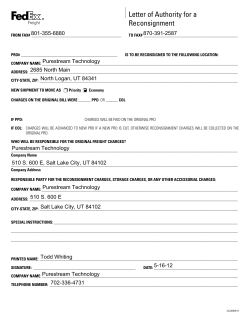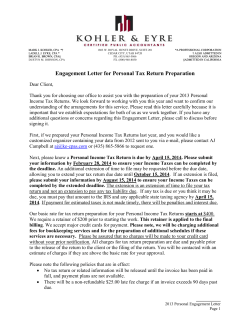
Delivery Rates
Frequently Asked Questions Regarding Sharyland Utilities’ Regulated Delivery Rates The purpose of this document is to provide answers to Frequently Asked Questions asked by our customers about the regulated delivery rates charged by Sharyland Utilities. For more information, please visit www.sharyland.com/rates or call our Customer Service Department at 800-442-8688. When I look at my monthly electric bill, I see there are energy charges from my Retail Electric Provider and delivery charges from Sharyland. Why is that? In Texas’ competitive electric market, customers receive a monthly bill from their Retail Electric Provider (REP), and essentially, there are two different types of charges that make up that bill: 1) Energy charges are what you pay to the REP to cover the price of power for the amount of electricity you consumed. Energy charges are unregulated and are set by your REP in the competitive market. 2) Delivery charges (or “wires” charges) are what you pay to cover the cost of delivering that power to your home or business. These delivery charges are calculated using rates that are regulated and set by the Public Utility Commission of Texas (PUCT). You pay these charges to the REP as part of their bill, and it is the REP’s responsibility to pay Sharyland for the cost of delivering electricity to your home or business. Over the past year, my electric bill has risen significantly due to an increase in Sharyland’s regulated delivery rates. Why did Sharyland’s rates go up? Sharyland’s regulated delivery rates for residential customers in the Midland, Stanton, Brady, Celeste and Colorado City areas increased as a result of our 2013 rate case (PUCT Docket No. 41474), which was approved by the PUCT in January 2014. Although the overall revenue collected by Sharyland for delivery service did not increase, the amount of revenue collected from each customer class was adjusted, causing residential rates to increase and rates to other customers to decrease. The new rates were phased in over two stages starting in May 2014. The second stage began in March 2015. What is a rate case? A rate case is an official proceeding where the PUCT reviews and sets the rates for regulated investorowned utilities (IOUs) like Sharyland. Rate cases follow a very deliberate and fair process that is open and transparent and where all parties have an opportunity to participate. In a typical rate case, rates are set to cover the costs of service to deliver electricity to specific customer classes. So, residential rates are set to cover costs to serve residential customers, and non-residential rates are set to cover costs to serve nonresidential customers. Did Sharyland notify customers about its rate case in 2013? Yes. When we filed the rate case in May 2013, we provided written notice to all of our customers to let them know they had an opportunity to participate. 1 April 2015 Why did Sharyland file a rate case in 2013? Our 2013 rate case was a result of Sharyland’s acquisition of Cap Rock Energy (CRE) in 2010. CRE was an electric cooperative (co-op) for many decades before it became a regulated IOU in 2002. Co-ops are not regulated by the PUCT, so they can set their own rates. This allows co-ops to charge lower rates to residential customers by charging higher rates to commercial and industrial customers. In 2002, CRE converted from a co-op into an IOU and became regulated by the PUCT. Its rates were then subject to review by the PUCT under the usual standard that customer rates should reflect their actual cost of service to each customer class. But in its first rate case as an IOU, the CRE cost of service study was deemed flawed and rates were kept at historical levels such that residential rates were lower than their actual cost of service and non-residential rates were higher. In 2010, the PUCT approved Sharyland’s acquisition of CRE and asked us to study and file a plan to move all of our customers into retail competition. In 2011, we filed our competition plan under PUCT Docket No. 39592. As part of that plan, we knew we would have to unbundle our rates and remove the energy charge component that previously existed in CRE’s rate structure, since energy charges would now be deregulated and set by the REPs in the open market. Did Sharyland seek to increase rates in its 2013 rate case? No. In fact, we proposed to allocate the costs in such a way so our rates would remain near their previous levels. In filed testimony, Sharyland warned that moving our residential customers to a purely cost-based tariff rate could increase their charges by 65%, while our larger non-residential customers could receive reductions over 50%. Sharyland expressed these concerns in our direct testimony as part of the initial filing, and again in our rebuttal testimony as a response to testimony filed by other parties who participated in the rate case. This is a matter of public record, and both Sharyland’s testimony and the testimony of the other parties who participated in the rate case can be found on the PUCT’s website. A link to the specific PUCT website and copies of key Sharyland testimony can be found on our website at www.sharyland.com/rates. In the end, our 2013 rate case was settled and approved by the PUCT, and the practical effect of the new rate structure was that rates for certain non-residential customers decreased, while rates for residential customers had to increase due to their cost of service. To mitigate the impact on residential customers, the rate increases were phased in over two stages. Why are Sharyland’s delivery rates higher than those charged by neighboring utilities? Our rates are a function of our costs, and because we primarily serve rural communities, our cost of serving customers is higher. Sharyland averages only 5 customers per mile, whereas most other utilities have much greater customer density to spread out their costs due to the fact they also serve customers in large urban areas. When is Sharyland’s next rate case? Sharyland’s next rate case is scheduled to be filed in mid-2016. We are currently gathering both billing and load usage data throughout 2015 as a test year in preparation for that filing. 2 April 2015 In the meantime, what can I do to lower my bill? In the short term, we recommend two things that could help our customers reduce their bills: 1) Shop around for a lower energy rate. Our regulated delivery rates are just one part of your bill. There is also the unregulated energy charge for the power you consume. We encourage our customers to look at their bills closely and see what energy rate they are paying to their REP. Customers should shop around and choose a REP that best suits their needs in order to make sure they are getting the best energy rate possible. 2) Try and conserve energy usage. Sharyland offers energy efficiency programs that can help customers reduce their usage, and we can help our lower income customers access programs provided by the PUCT. Customers can find more information on our website at www.sharyland.com or by calling our Customer Service Department at 800-442-8688 for more information. For the long term, we encourage our customers to get involved. We are scheduled to file our next rate case in mid-2016, and we hope that all of our customers will actively engage in that process to ensure that fair rates are established for all rate classes. Sharyland is also working with the PUCT in a Project that has been opened to address customer rate complaints. It is Project No. 44592, and you are invited to participate in that Project by sending your information and concerns to the PUCT. A link to this Project can be found on our webpage at www.sharyland.com/rates. 3 April 2015
© Copyright 2025









